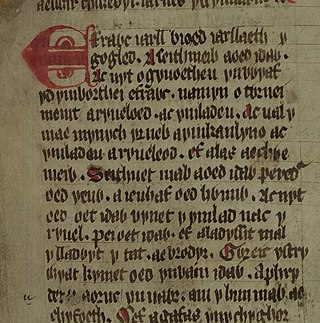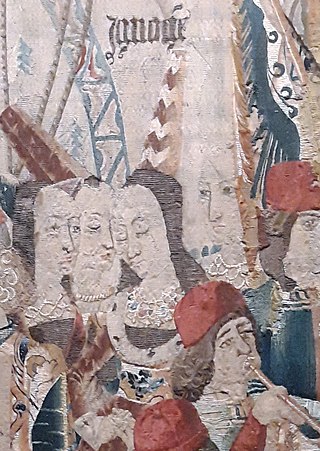External links
- Gesta regum Britanniae, edition by Francisque Michel
The Gesta Regum Britanniae (Latin : Deeds of the Kings of Britain) is a Latin epic written at some time between 1235 and 1254, and attributed to a Breton monk, William of Rennes.
The Gesta is fundamentally a versification of Geoffrey of Monmouth's Historia Regum Britanniae in Latin epic hexameters. It retains Geoffrey's overall sequence and structure, but expands upon those elements and stories which had the greatest dramatic potential, while treating other sections more cursorily. William omits the Prophecies of Merlin section of the Historia, as Wace did in his earlier Roman de Brut . William may have read Geoffrey's Vita Merlini , but otherwise does not intrude any elements of the (by then very copious) Arthurian legend into his adaptation of the Historia.
The form of the Gesta was inspired by Walter of Châtillon's Alexandreis . It is divided into ten books, each of which is prefaced by a terse summary of its contents, also in verse. The entire poem is 4,923 lines long, each book being about 500 lines in length.

Geoffrey of Monmouth was a Catholic cleric from Monmouth, Wales, and one of the major figures in the development of British historiography and the popularity of tales of King Arthur. He is best known for his chronicle The History of the Kings of Britain which was widely popular in its day, being translated into other languages from its original Latin. It was given historical credence well into the 16th century, but is now considered historically unreliable.
William of Malmesbury was the foremost English historian of the 12th century. He has been ranked among the most talented English historians since Bede. Modern historian C. Warren Hollister described him as "a gifted historical scholar and an omnivorous reader, impressively well versed in the literature of classical, patristic, and earlier medieval times as well as in the writings of his own contemporaries. Indeed William may well have been the most learned man in twelfth-century Western Europe."

King Lot, also spelled Loth or Lott, is a British monarch in Arthurian legend. He was introduced in Geoffrey of Monmouth's pseudohistorical Historia Regum Britanniae as King Arthur's brother-in-law, who serves as regent of Britain between the reigns of Uther Pendragon and Arthur. He has appeared regularly in works of chivalric romance, alternating between the roles of Arthur's enemy and ally, and is often depicted as the ruler of Lothian and either Norway or Orkney. His literary character is probably derived from hagiographical material concerning Saint Kentigern, which features Leudonus as king of Leudonia and father of Saint Teneu.

Historia regum Britanniae, originally called De gestis Britonum, is a pseudohistorical account of British history, written around 1136 by Geoffrey of Monmouth. It chronicles the lives of the kings of the Britons over the course of two thousand years, beginning with the Trojans founding the British nation and continuing until the Anglo-Saxons assumed control of much of Britain around the 7th century. It is one of the central pieces of the Matter of Britain.
Trinovantum is the name in medieval British legend that was given to London, according to Geoffrey of Monmouth's Historia Regum Britanniae, when it was founded by the exiled Trojan Brutus, who called it Troia Nova, which was gradually corrupted to Trinovantum. The legend says that it was later rebuilt by King Lud, who named it Caer Lud after himself and that the name became corrupted to Kaer Llundain and finally London. The legend is part of the Matter of Britain.

Peredur is the name of a number of men from the boundaries of history and legend in sub-Roman Britain. The Peredur who is most familiar to a modern audience is the character who made his entrance as a knight in the Arthurian world of Middle Welsh prose literature.
Cador is a legendary Duke of Cornwall, known chiefly through Geoffrey of Monmouth's pseudohistorical Historia Regum Britanniae and previous manuscript sources such as the Life of Carantoc. In Welsh genealogical records, he appears as Cado, the son of Cornish king Geraint. Early sources present him as a relative of King Arthur, though the details of their kinship are usually left unspecified.
Historians in England during the Middle Ages helped to lay the groundwork for modern historical historiography, providing vital accounts of the early history of England, Wales and Normandy, its cultures, and revelations about the historians themselves.
The Treason of the Long Knives is an account of a massacre of British Celtic chieftains by Anglo-Saxon soldiers at a peace conference on Salisbury Plain in the 5th century. The story is thought to be pseudohistorical as the only surviving records mentioning it are centuries later in the semi-mythological histories of the Historia Brittonum and the Historia Regum Britanniae. Though a popular cautionary tale in medieval Europe, there is no other historical evidence for The Treason of the Long Knives. Most historians interpret the story as a purely literary construction.

Innogen is a character in the Historia Regum Britanniae and subsequent medieval British pseudo-history. She was said to have been a Greek princess, the daughter of King Pandrasus, and to have become Britain's first Queen consort as the wife of Brutus of Troy, the purported first king of Britain who was said to have lived around the 12th century BC. Her sons Locrinus, Camber, and Albanactus went on to rule Loegria, Cambria, and Alba respectively.
Llefelys is a character in Welsh mythology appearing in the medieval Welsh tale Cyfranc Lludd a Llefelys. In the tale, Llefelys is king of Gaul while his brother Lludd is king of Britain. The tale appears in the Red Book of Hergest and the White Book of Rhydderch, the source texts for the Mabinogion, and embedded into various versions of the Brut y Brenhinedd, the Welsh adaptation of Geoffrey of Monmouth's Historia Regum Britanniae.
Pridwen was, according to the 12th-century writer Geoffrey of Monmouth, King Arthur's shield; it was adorned with an image of the Virgin Mary. Geoffrey's description of it draws on earlier Welsh traditions found in Preiddeu Annwfn, Culhwch and Olwen, and the Historia Brittonum. The shield is also named and described by Wace, Layamon, Roger of Wendover and Robert of Gloucester among other medieval writers, and it directly inspired the description of Sir Gawain's shield in Sir Gawain and the Green Knight.
The Gesta Regum Anglorum, originally titled De Gestis Regum Anglorum and also anglicized as The Chronicles or The History of the Kings of England, is an early-12th-century history of the kings of England by William of Malmesbury. It is a companion work of his Gesta Pontificum Anglorum and was followed by his Historia Novella, which continued its account for several more years. The portions of the work concerning the First Crusade were derived from Gesta Francorum Iherusalem peregrinantium, a chronicle by Fulcher of Chartres.

Rowena in the Matter of Britain was the daughter of the purported Anglo-Saxon chief Hengist and wife of Vortigern, "King of the Britons". Presented as a beautiful femme fatale, she won her people the Kingdom of Kent through her treacherous seduction of Vortigern. Contemporary sources are nearly non-existent, so it is impossible to know if she actually existed.

Brut y Brenhinedd is a collection of variant Middle Welsh versions of Geoffrey of Monmouth's Latin Historia Regum Britanniae. About 60 versions survive, with the earliest dating to the mid-13th century. Adaptations of Geoffrey's Historia were extremely popular throughout Western Europe during the Middle Ages, but the Brut proved especially influential in medieval Wales, where it was largely regarded as an accurate account of the early history of the Celtic Britons.
Walter of Oxford was a cleric and writer. He served as archdeacon of Oxford in the 12th century. Walter was a friend of Geoffrey of Monmouth, who claimed he got his chief source for the Historia Regum Britanniae from him.
The River Malvam, also known as the Malva or Malua is a river in ancient North Africa mentioned in the Historia Brittonum and Historia Regum Britanniae. In these accounts, it lies west of the Mountains of Azaria in Mauretania. Academics have identified it as the present-day Moulouya River.

Goffar known as Goffar the Pict, was a pseudo-historical king of Aquitaine around the year 1000 BCE in Geoffrey of Monmouth's Historia Regum Britanniae. In the story, he was defeated by Brutus of Troy and Corineus on their way to Britain. Later histories of Britain and France included Goffar from Historia Regum Britanniae, and sometimes expanded the story with additional details.
William of Rennes, OP was a French friar in the Dominican Order, was a poet, theologian and expert on canon law. William was a Breton born in Thorigné in the thirteenth century.